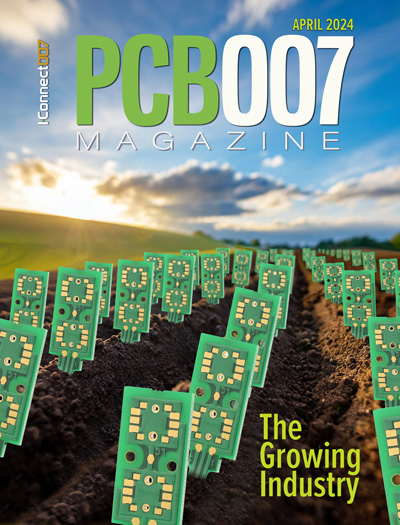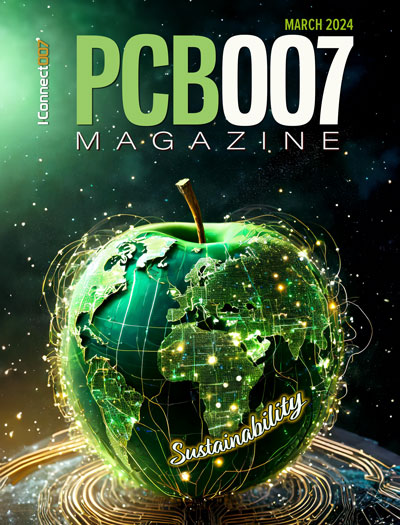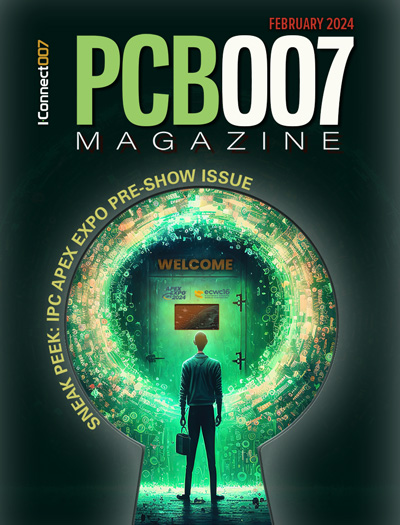-

- News
- Books
Featured Books
- pcb007 Magazine
Latest Issues
Current Issue
The Growing Industry
In this issue of PCB007 Magazine, we talk with leading economic experts, advocacy specialists in Washington, D.C., and PCB company leadership to get a well-rounded picture of what’s happening in the industry today. Don’t miss it.

The Sustainability Issue
Sustainability is one of the most widely used terms in business today, especially for electronics and manufacturing but what does it mean to you? We explore the environmental, business, and economic impacts.

The Fabricator’s Guide to IPC APEX EXPO
This issue previews many of the important events taking place at this year's show and highlights some changes and opportunities. So, buckle up. We are counting down to IPC APEX EXPO 2024.
- Articles
- Columns
Search Console
- Links
- Events
||| MENU - pcb007 Magazine
Project HiperLAM Delivers Outstanding Results Using PV Nano Cell’s Sicrys Ink
June 17, 2020 | PV Nano CellEstimated reading time: 1 minute
PV Nano Cell Ltd, an innovative provider of inkjet-based conductive digital printing solutions and producer of conductive digital inks, announced that its Sicrys™ ink was successfully used to deliver exceptional results in HiperLAM—a European Union-funded program to laser print RFID antennas and fingerprint sensors.
The HiperLAM project is focused on demonstrating superior cost and speed performance in end-to-end processes featuring laser-based additive manufacturing. Two key applications requiring high resolution printed conductive metallic lines are studied. Laser printed RFID antennas and laser printed fingerprint sensors. The project received funding from the European Union's Horizon 2020 Research and Innovation Program under Grant Agreement No. 723879.
PV Nano Cell’s Chief Executive Officer, Dr. Fernando de la Vega, commented, “We are happy to yet again join hands with some of the leading researchers and commercial companies in the world to develop new digital additive manufacturing technologies. This time we focus on LIFT – Laser Induced Forward Transfer technology. This technology enables printing in both solid and liquid phase, down to 10 µm in resolution, a variety of materials are supported and no use of nozzles. We provided our specially designed ink to accommodate the unique needs of the technology and I'm happy to share the results were very impressive. The lines width achieved is around 90 µm and the pitch is around 20 µm. The printed samples are of excellent quality, with low resistance and suitable for high frequency band applications.”
One of the leading partners in this program is NTUA - National Technical University of Athens. Professor Ioanna Zergioti from the School of Applied Mathematics and Physical Sciences commented, “Our collaboration with PV Nano Cell (PVN) resulted in new scientific results but also in new products. This combination is very difficult to achieve and we thank the team from PVN for their contribution to deliver high quality work and producing new inks for the digital printing process.”
PV Nano Cell’s Chief of Business Development Officer, Mr. Hanan Markovich commented, “Demonstrating commercial capabilities of the LIFT technology is of high importance to PV Nano Cell as we develop additional additive manufacturing products for conductive printing. We believe there is great potential in using lasers to print and that this technology is complementary to inkjet printing. We've already started to formulate new partnerships in this area and look forward to growing the business with yet another, new and exciting potential growth engine.”
Suggested Items
SIA Applauds CHIPS Act Incentives for Samsung Manufacturing Projects in Texas
04/16/2024 | SIAThe Semiconductor Industry Association (SIA) released the following statement from SIA President and CEO John Neuffer applauding semiconductor manufacturing incentives announced by the U.S. Department of Commerce and Samsung.
Report Reveals ‘True Impact’ of Manufacturing is Nearly a Quarter of UK GDP
04/15/2024 | Manufacturing Technologies AssociationManufacturing is having a far greater impact on the UK economy than first thought according to a major new report released today.
Design Community Town Hall Review
04/11/2024 | Kelly Dack, CID+, EPTACThe Design Community Town Hall took place on the afternoon of April 10, 2024. I was fortunate to attend this event, which marked an opportunity for members of some newly found design groups to get together and exchange ideas. Peter Tranitz, senior director of solutions for IPC, opened the session with a slide presentation introducing these new groups and members within the solutions department.
Aegis Software and JUKI Extend Reseller Relationship, Marking Over 23 Years of Collaboration
04/11/2024 | Aegis SoftwareAegis Software, a global provider of Manufacturing Execution System (MES) software, announces that JUKI Automation, a world-leading provider of automated assembly products and systems and subsidiary of JUKI Corporation, has renewed their reseller relationship with Aegis Software.
Mycronic Receives Order for an SLX Mask Writer
04/11/2024 | MycronicMycronic AB has received an order for an SLX mask writer from a new customer in Asia. The order value is in the range of USD 7-9 million. Delivery of the system is planned for the second quarter of 2025.


